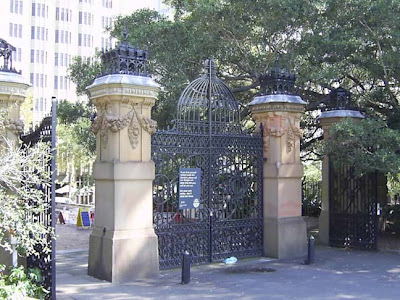Only one good thing came out of this horrible era. Greenway had been friendly with Arthur Phillip (ex Governor of NSW) who was living in retirement at Bath, and Phillip wrote to Lachlan Macquarie (current Governor of NSW), recommending Greenway to him.
Hyde Park Barracks, main entrance
Between 1816-18, Convict Greenway was responsible for the design & construction of colonial buildings! So successful was he that the Governor of New South Wales, Lachlan Macquarie, gave Greenway his ticket of leave. He was a free man. And as Acting Civil Architect, he went on to build many significant buildings in the new colony.
Hyde Park Barracks, convicts' sleeping space
Sydney has 49 extant buildings attributed to Greenway's designs. If these buildings had been in Melbourne, and had been built several decades later, Greenway might have been asked to design banks, gold safes, the royal mint and a customs office. But early Sydney had a penal population, so they required facilities more suited to law and order.
St James' Church
Greenway sited the Hyde Park Barracks directly opposite St James Church in Macquarie St. And the courthouse was built on a site immediately to the west of St James Church, thus forming a linear relationship with both the church and the barracks. Johnson showed that Greenway was clearly interested in the individual buildings AND in a total civic context for the new city.
St James' Church, looking towards the apse
The barracks remained in active service until 1848, and now the building functions as an excellent museum of colonial Sydney.
St James’ Church, designed by Greenway in 1819 in the Old Colonial Regency style, was originally designed as a courthouse – a purpose revealed by two strange, non-clerical elements: the very large western gallery and the central positioning of the porch. The building wasn’t consecrated as a church until 1824, so clearly there were already Anglican churches in the colony. Nonetheless Gov Macquarie saw this church as one of the key elements of his town plan for Sydney and St James’ Church became the site in which the first Bishop of Australia was installed, in 1836.
The interior of the church, which today looks as it was following the renovations of 1900-1902, faces east. Note the sanctuary that is set within an apse with gold mosaic semi-dome. The sanctuary has marble and mosaic flooring, and is flanked by the organ and choir. The church connection to law and order is still celebrated today: the beginning of the legal year is marked with a church service attended by the Supreme Court justices, fully robed up.
In July 1813, Governor Macquarie, aware of the need for a court house in Sydney, started a public subscription for the building. An appeal was launched, but few of the settlers shared the official enthusiasm. Soon the appeal was abandoned and Governor Macquarie reluctantly decided that if he was to have a court house, it would have to be built with convict labour.
He engaged an architect to produce a design for the building. When the plans for a two-storey building with two wings and a Doric portico were finished, Gov Macquarie sent the plans and a request for funds to Earl Bathurst, the Secretary of State for the Colonies in London. But funds were denied.
Supreme Court
Alas Bigge intervened and Macquarie felt he had to follow Bigge’s advice. Greenway set about converting the design for the court house and work proceeded. However the building was still incomplete when Macquarie left the colony in Dec 1821. Greenway protested to Macquarie's successor, Governor Sir Thomas Brisbane. But Brisbane would not debate architecture with an ex-convict. Thereafter Greenway's relations with officialdom went downhill, until he was dismissed from the Government service in 1822.
After his dismissal, Greenway strongly criticised the work being done on “his” courthouse. Apart from the circular staircase, the Doric portico at the western end of the building, the window treatment and certain recessed wall panels, quite a lot of Greenway's original design did not survive. Still, in 1824, the first Chief Justice of NSW read the Charter of Justice establishing the Supreme Court of New South Wales. The building itself was completed by 1828.
Greenway on the ten dollar note

































